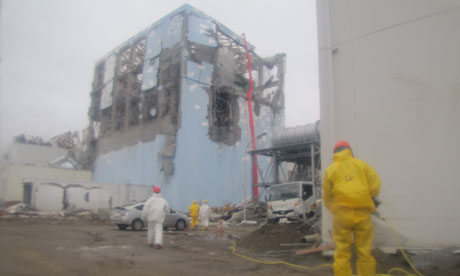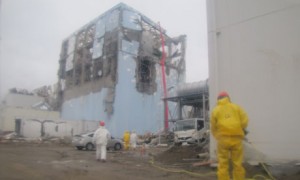A review of nuclear safety in the UK has found 38 areas where safety could be improved, in lessons drawn from the Fukushima incident in Japan early this year.
The review, ordered by the government following the Japanese experience, pinpointed critical areas for concern, including risks associated with flooding, the layout of plants, and the state of preparedness for emergencies. Ministers and the relevant regulators will be asked to look at these as a matter of urgency.
However, the review published on Tuesday also concluded that the UK’s nuclear industry is broadly safe, with “no fundamental safety weaknesses”. If the areas of concern raised in the light of the Fukushima are addressed, the industry will be “even safer”, the report said. The relatively clean bill of health was rapidly seized on by the government.

Mike Weightman, the chief inspector of nuclear installations and executive head of the Office for Nuclear Regulation, who carried out the review, said: “I remain confident that our UK nuclear facilities have no fundamental safety weaknesses. [We] already require protection of nuclear sites against the worst-case scenarios that are predictable for the UK. But we are not complacent. Our philosophy is one of continuous improvement. No matter how high our standards, the quest for improvement must never stop. We will ensure lessons are learned from Fukushima. Action has already been taken in many cases, with work underway to further enhance safety at UK sites.”
Chris Huhne, the climate and energy secretary, said: “The report makes clear that the UK has one of the best nuclear safety regimes in the world, and that nuclear power can go on powering homes and businesses across the UK, as well as supporting jobs. We must however continue to improve where we can, not just with operating power stations and new sites, but by dealing with our nuclear legacy in a robust and effective manner too.”
Huhne stopped short of calling for a new generation of nuclear plants, as the Liberal Democrats party, to which he belongs, does not support nuclear newbuild – unlike its Conservative coalition partners.
The government said it would give the Office for Nuclear Regulation statutory powers to improve safety.
Among the lessons highlighted in the report were the need to prioritise safety reviews and to review plants’ reliance on off-site infrastructure such as the electrical grid, in case of serious disruptions such as natural disasters. When power grids were shut down by the Japanese tsunami, there were problems in powering the water pumps needed to cool the stricken reactors.
Floods or earthquakes could cause radioactivity to leak into the environment from Britain’s nuclear bomb factories, Weightman’s review also revealed. In a submission to the review, the Atomic Weapons Establishment (AWE) said that some of the sensitive operations carried out at Aldermaston and Burghfield in Berkshire were “vulnerable” to flooding or seismic damage.
Burghfield was badly flooded after heavy rain in July 2007, which an internal AWE report said caused severe disruption and “extensive damage” to an explosives area. But the report stressed that there was no “threat to the nuclear safety of either the AWE sites, the public or the environment.”
Now, however, in a 40-page submission to the Weightman review by the Office for Nuclear Regulation, AWE accepts that radioactivity could escape. “Some containment may be vulnerable to flooding in which case some limited spread of radiological contamination could occur,” it said. This would be “a minor consequence event”, AWE added. “Some containment (process and structures) may be vulnerable to damage from a seismic event. There could be particulate release as a result of loss of containment or fire.”
The AWE submission also disclosed that it was dependent on electricity
from the National Grid in the event of emergencies. As a result of a review, “the on-site electricity distribution system is to be enhanced over the coming year”, AWE said. “This enhancement unill remove any nuclear safety dependency on the national grid.”
Responding to the review, the Royal Academy of Engineering (RAE) issued a statement in favour of pursuing nuclear energy, but warned that it must be balanced against risks. “Like all forms of power generation nuclear power is not without risk. The seriousness and potential global nature of accidents in the nuclear industry bring particular challenges,” the RAE said.
“Continued vigilance, transparency and co-operation by all countries and organisations must be maintained on issues of safety and security. The potential scale of a disaster means that, despite the fact that accidents are rare, traditional probabilistic methods of assessing the risk should be supplemented with contingency plans to deal with all conceivable eventualities.”
Weightman and his team visited Japan in June, and saw the Fukushima plant and the actions that had been taken to make it safe. They were given access to detailed information about the plant’s workings, and met and talked to the workers involved in the clean-up. Weightman also took account of evidence from the International Atomic Energy Agency and energy companies.
The Fukushima plant was the source of a serious radiation leak, which took weeks to bring under control and is still the subject of an ongoing clean-up and monitoring operation.
Weightman said: “While it is only six months since the earthquake and tsunami hit Japan, I am satisfied we are in a position to have drawn reliable conclusions and identified the main lessons to improve safety. Detailed technical information will no doubt continue to emerge and the Office for Nuclear Regulation will continue to monitor it and take action as necessary.”
Sue Ion, fellow of the Royal Academy of Engineering, said: “This report also emphasises the issues associated with the long-term management of the UK’s historic legacy sites where there are significant engineering challenges and where ‘utmost vigour and determination’ should be taken to ensure their clean up and decommissioning.”
But independent nuclear analyst John Large said the review was a “whitewash”.
“I see the hidden hand of the industry being very influential. There is nothing here to counter the gung-ho contention that everything is fine. Everyone acknowledges the severe failures in the way that the Japanese reported Fukushima. If the UK regulators have depended on the Japanese they have not taken good advice.”
Large questioned why aircraft crashes had not been considered and said that security issues had been glossed over. “Fukushima was a gift to terrorists. They now know how vulnerable these reactors are. The real gap [in the report] is that UK reactors would not survive more than an hour without power. They have not released the reports done under stress testing. I fear the regulators has just fallen into line with government. This is a ‘let’s not rock-the-boat response’.”
Paul Dorfman, a senior researcher at the University of Warwick, and a member of the Nuclear Consultation Group, said the review was partial and flawed. “It has not looked at the size of emergency planning zones around UK reactors [about 3km] compared with the 30km evacuation area in Japan; it leaves open key questions about flooding and security risks. Accidents are by nature, accidental. The cost of occluding this commonsense axiom can prove radiologically catastrophic.”
Green politicians and groups were also critical of the review. Green MP Caroline Lucas said: “This will do little to reassure the public that the nuclear industry can be trusted to power our energy future. The status of our nuclear facilities is a crucial national security issue, yet the government has concluded that nothing needs to change in the light of the Japanese disaster – the largest nuclear accident since Chernobyl – even before it has submitted the UK’s assessment of our facilities to the EU’s ‘stress test’ process, due in November.”
Louise Hutchins, energy campaigner at Greenpeace, said: “This looks like a rushed report, before the full implications are known about Fukushima. It’s designed with one objective – to give the green light to a new generation of nuclear power stations, irrespective of the safety, environmental or rising financial costs of those nuclear stations. This is government complacency.”
Source: guardian

 Follow
Follow